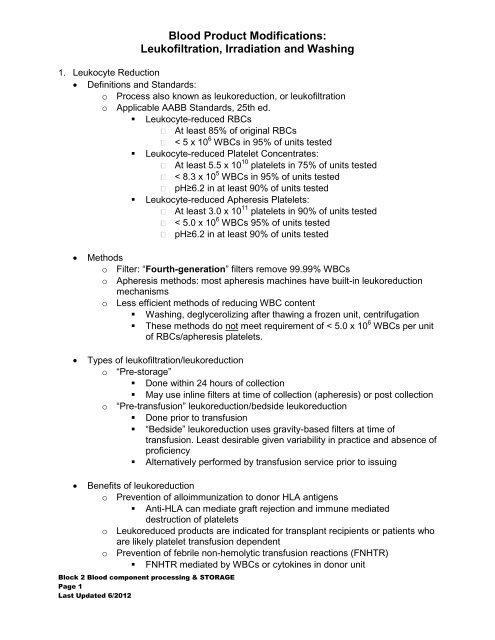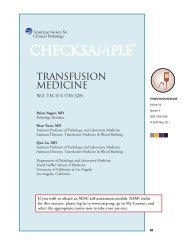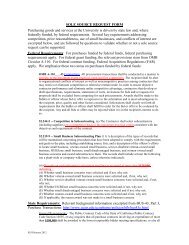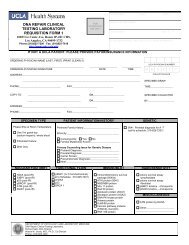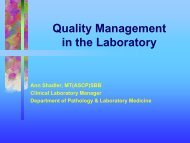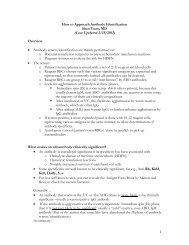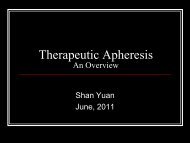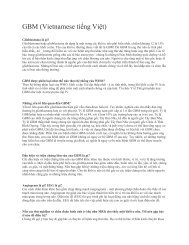Blood Product Modifications: Leukofiltration, Irradiation and Washing
Blood Product Modifications: Leukofiltration, Irradiation and Washing
Blood Product Modifications: Leukofiltration, Irradiation and Washing
Create successful ePaper yourself
Turn your PDF publications into a flip-book with our unique Google optimized e-Paper software.
<strong>Blood</strong> <strong>Product</strong> <strong>Modifications</strong>:<strong>Leukofiltration</strong>, <strong>Irradiation</strong> <strong>and</strong> <strong>Washing</strong>1. Leukocyte Reduction Definitions <strong>and</strong> St<strong>and</strong>ards:o Process also known as leukoreduction, or leukofiltrationo Applicable AABB St<strong>and</strong>ards, 25th ed.• Leukocyte-reduced RBCsAt least 85% of original RBCs< 5 x 10 6 WBCs in 95% of units tested• Leukocyte-reduced Platelet Concentrates:At least 5.5 x 10 10 platelets in 75% of units tested< 8.3 x 10 5 WBCs in 95% of units testedpH≥6.2 in at least 90% of units tested• Leukocyte-reduced Apheresis Platelets:At least 3.0 x 10 11 platelets in 90% of units tested< 5.0 x 10 6 WBCs 95% of units testedpH≥6.2 in at least 90% of units testedMethodso Filter: “Fourth-generation” filters remove 99.99% WBCso Apheresis methods: most apheresis machines have built-in leukoreductionmechanismso Less efficient methods of reducing WBC content• <strong>Washing</strong>, deglycerolizing after thawing a frozen unit, centrifugation• These methods do not meet requirement of < 5.0 x 10 6 WBCs per unitof RBCs/apheresis platelets.Types of leukofiltration/leukoreductiono “Pre-storage”• Done within 24 hours of collection• May use inline filters at time of collection (apheresis) or post collectiono “Pre-transfusion” leukoreduction/bedside leukoreduction• Done prior to transfusion• “Bedside” leukoreduction uses gravity-based filters at time oftransfusion. Least desirable given variability in practice <strong>and</strong> absence ofproficiency• Alternatively performed by transfusion service prior to issuingBenefits of leukoreductiono Prevention of alloimmunization to donor HLA antigens• Anti-HLA can mediate graft rejection <strong>and</strong> immune mediateddestruction of plateletso Leukoreduced products are indicated for transplant recipients or patients whoare likely platelet transfusion dependento Prevention of febrile non-hemolytic transfusion reactions (FNHTR)• FNHTR mediated by WBCs or cytokines in donor unitBlock 2 <strong>Blood</strong> component processing & STORAGEPage 1Last Updated 6/2012
<strong>Blood</strong> <strong>Product</strong> <strong>Modifications</strong>:<strong>Leukofiltration</strong>, <strong>Irradiation</strong> <strong>and</strong> <strong>Washing</strong>• Indicated for patients who had FNHTRso Prevention of CMV transmission• CMV virus reside within WBC; leukoreduction reduces risks TT-CMV• Considered equivalent to products collected from CMV seronegativedonors (“CMV-safe”)o Prevention of immunosuppressive effects of transfusion (controversial)2. <strong>Irradiation</strong> Goal of <strong>Irradiation</strong>o Prevention of TA-GVHD (Transfusion Associated Graft vs. Host Disease).o Causes DNA crosslinks, thereby preventing lymphocyte replication withoutsignificantly damaging red blood cell, platelet or granulocyte functionWhat is TA-GVHD?o Transfused viable lymphocytes (CD4+ <strong>and</strong> CD8+) would attempt to mount animmune response against HLA incompatible host tissueo Normally, host lymphocytes counterattack <strong>and</strong> neutralize the responseo Lack of host neutralization due to defective cellular immunity, or failure torecognize donor HLA molecule as foreign, may lead to transfusion-associatedgraft versus host disease (TA-GVHD) mediated by transfused lymphocyteso TA-GVHD:• Almost uniformly fatal without successful bone marrow transplant• Hallmark: bone marrow attacked leading to marrow fibrosis <strong>and</strong>aplasia /pancytopenia• Organ systems affected: Skin (rash), GI (diffuse mucositis/ diarrhea),liver (hepatitis, veno-occlusive disease)Who Is at Risk <strong>and</strong> Who Needs Irradiated Cellular <strong>Product</strong>s?o Immune suppressed patients with deficient cellular immunity:o Congenital T-cell deficiencies syndromes (DiGeorge’s, SCID, Wiskott-Aldrich)o Stem cell/bone marrow transplantation• Note: Because many patients with diagnosis of hematologicalmalignancies go on to receive stem cell transplants, they are alsogiven irradiated products.o Intrauterine or exchange transfusions for premature neonate transfusionso Treatment with purine analogues, like fludarabineo Premature infants (weighing
<strong>Blood</strong> <strong>Product</strong> <strong>Modifications</strong>:<strong>Leukofiltration</strong>, <strong>Irradiation</strong> <strong>and</strong> <strong>Washing</strong>believed to be from lymphocytes in the transplanted organ <strong>and</strong>NOT from subsequent transfused blood components. Thus,irradiated blood components are only necessary for solid organtransplant recipients if they have some other indication such asconcurrent bone marrow transplant or the use ofpurine analogues, like fludarabine, both which have beenassociated with TA-GVHD.• Patients who are on “very immune suppressive” chemotherapy orirradiationHost not recognizing donor lymphocytes as “foreign”, but donor lymphocytes mayrecognize host as foreigno HLA-heterozygous recipient getting blood from a HLA-homozygous donor,<strong>and</strong> the homozygous HLA allele is shared• Receiving blood from a first-degree relative donor (All directed donorunits are irradiated.)• -matched” units•patient is in a HLA-homogeneous populationInteresting fact: In Japan, all products are irradiated.Methodso Dose of irradiation(AABB St<strong>and</strong>ards):• Dose to the center of the irradiation field must be at least 2500 cGy(25 Gy).• Minimum delivered dose delivered to any other portion must be 1500cGy.• No more than 5000 cGy should be delivered to the product.o Accomplished using cesium-137 or cobal-60 in self contained bloodirradiators.o X-ray irradiator also availableo Special labels (radiochromic film labels which change color upon beingirradiated) are affixed to units to confirm irradiation of an adequate dosageo Process takes 5minutes or soShelf Life of Irradiated <strong>Product</strong>so RBC products: Shortened to 28 days after irradiation (due to increase inK+ <strong>and</strong> free hemoglobin in supernatant of red cell units after irradiation) oruntil original expiration date, whichever comes firsto Platelets: No changeo Granulocytes: No change3. <strong>Washing</strong> Goal: To remove plasma/supernatant in RBC/platelet productsBlock 2 <strong>Blood</strong> component processing & STORAGEPage 3Last Updated 6/2012
<strong>Blood</strong> <strong>Product</strong> <strong>Modifications</strong>:<strong>Leukofiltration</strong>, <strong>Irradiation</strong> <strong>and</strong> <strong>Washing</strong>Even though allergen may never be identified, a trial withwashed products is reasonable• RBC unit for patients “sensitive” to hyperkalemiaRBC unit accumulates K+ during storage:Patients who may develop hyperkalemia are those who:receive large volumes of products, received older RBCs, thosewith pre-existing renal/liver disease, <strong>and</strong> neonatesMost adult patients tolerate single units of RBCs withoutproblem. K+ content in each unit (even older units) is notexcessiveAlternatives to washing:• Offer fresh units (e.g: < 10 days old)•removed <strong>and</strong> replaced with saline. Process lesslaborious <strong>and</strong> time consuming• Paroxysmal Nocturnal HemoglobinuriaCaused by loss of complement decaying factors on RBCs (lossof CD55 <strong>and</strong> CD 59), therefore increased complementmediated hemolysisThought is that transfusing plasma may add fuel to the fire, asmore complement proteins are given to the patientFear may be unwarranted, because patient’s own complementproteins are much more significant in amountIf patient has tolerated platelet or plasma transfusions well,then washing RBCs is clearly unnecessaryBlock 2 <strong>Blood</strong> component processing & STORAGEPage 5Last Updated 6/2012


